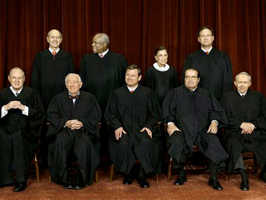
It’s been a very long time since I sat in my Constitutional Law 101 class. My interest was low and went lower after Marbury v. Madison. I may be just now starting to get it.
Some of you intrepid readers have advised me to stick to “funny stuff” and leave serious discussion to others. That’s advice I’ve more or less adhered to with few exceptions. I ask for an exception for this blog, however, under the theory that the practice of jurisprudence, particularly in the big leagues of the Supreme Court, often devolves into pretty funny stuff.
Take the Sotomayor hearings for example. There was an awful lot of funny stuff, most of which emanated from the old white men (and a few old white women) asking the same questions over and over and over again. The term judicial activism was thrown around as an epithet repeatedly. Most often it was offered in the connotation of, well I guess, a contagious disease. One grey haired old fool was actually tossing off spittle as he pointed the accusing finger at the hopeful justice-to-be. Justice Roberts in his own confirmation hearings had dismissed the notion of judicial activism with an ill conceived analogy to base ball umpires by intoning, “Judges are like umpires, they don’t make the rules. They just apply them…”. I don’t want to be catty, but that’s just about one of the dumbest things I’ve ever heard. I guarantee the Chief Justice John Roberts never played a lick of baseball. Has he ever heard of the strike zone? Duh. Every umpire that I’ve ever known has a different interpretation of where it is. I guess you could call it “umpirical activism”.
In any case, it got me to thinking. What exactly is Judicial Activism and should I want my next Justice to be one. A few definitions are in order because you’ll be seeing these later:
Judicial Activism: A philosophy advocating that judges should reach beyond the law (constitution) to achieve results consistent with contemporary conditions and values.
Strict Constructionism: A philosophy that would limit constitutional rights to those recognized by a limited group of people at a fixed date in history. The concept of original intent also get tangled up here as well. My fount of all sources defines it as a legal philosophy of judicial interpretation that restricts said interpretation to the original text. Huh?
Settled Law: When the Supreme Court decides a case, it becomes precedent which is given, under common law, great respect. As more and more cases are decided relying on prior decisions, and as time passes without substantial challenges, it becomes referred to as “settled law”. Until it is overturned, that is. Then the cycle starts anew. In actuality, as you will see, there is no such thing as settled law.
Activist Justice: Somebody whose ruling I don’t agree with.
Ok. Forget that last one. I was getting ahead of myself.
In an effort to get to the bottom line quickly I resorted to the beginning,. Well, actually not the beginning of judicial activism, but to the most extreme, well known example, and then I’ll let you be the judge.
At the end of the civil war (ours that is) the period of reconstruction was ended by the Compromise of 1877. I’ll not bore you with the details of this so called compromise, but after this ignominious act we entered the Jim Crow era in the south. In 1890 Louisiana enacted a law which required separate accommodations for black and whites on trains, but in a fit of enlightenment or guilt they required RR’s to provide “equal” cars for our black brethren. One Mr. Homer Plessy, himself 1/8th black, and by law a “negro” in Louisiana, was chosen to contest this law. Suffice it to say that it wound up with the Supremes who showed complete disregard for the 14th Amendment by affirming the ruling of the state courts and thereby establishing a dark period of American jurisprudence henceforth referred to as the “separate but equal” period. This was not a close call by the court. The final count was 7-1 with the only ex-slave owning judge dissenting.
Fast forward 58 years. BTW, one of the tests of “settled law” is how long does it stand. I’d say 58 years meets even the most rigorous test of settled law. In Brown v. Topeka Board of Education the court overturned 58 years of settled law and stare decisis (latin for affirming precedent) by opining 9-0 that, “…state laws that establish separate public schools for black and white students denies black students equal educational opportunities.” Separate educational facilities were ruled to be inherently unequal, and therefore in violation of Section 1 of the 14th Amendment…the so called Equal Protection Clause. Whoa…no more separate but equal. 58 years and hundreds of cases down the crapper. No more Jim Crow (well, almost no more) laws. Stare decisis out the gazoo. Done, gone. What changed in those 58 years? The Constitution? The intent of the framers? The actual text of the Constitution? Nah. None of that. What changed was the court and its view of whether or not blacks (and others) should be accorded the same human rights and educational facilities as whites. Our society changed it’s values and our Supreme Court changed with it. I’d label this judicial activism of the highest order. None would argue that we are not in a better place because of this particular spurt of activism.
As an interesting aside, Section 2 of this same 14th amendment which deals with apportionment says in part, “…counting the whole number of persons in each state, excluding indians…”. Hmm. Perhaps a little problem here with the “original intent”, strict construction theory here as well.
I awoke this morning to find in today’s Dallas Morning News that our fine Senator John Cornyn (R) Texas announced that he had determined he would vote no on Sotomayor’s confirmation. His reason. He thought that she had a tendency toward activism. I suppose he meant judicial activism. Hmmm. Doesn’t want her on the bench because she might overturn settled law.
Ironic, isn’t it that Cornyn, an ardent anti-abortionist, would vote against Sotomayor on the basis of a tendency towards activism when that is exactly what will be required to overturn Roe v. Wade. You see, don’t you, that Roe v. Wade and the cases that have followed in it’s path since 1973 have established “settled law” and substantial precedent over allowing a woman’s right to privacy extend to her reproductive rights. The anti-abortion movement now urges the Justices to “activism” by reinterpreting the 14th Amendment to extend the equal protection provision to the protection of the unborn. Their ideological zeal will come to naught unless they kind drum up some judicial activists of their own.
I end where I started. An activist judge is one whose ruling I don’t agree with, and the more strongly I disagree with it, the more activist I think they are.


